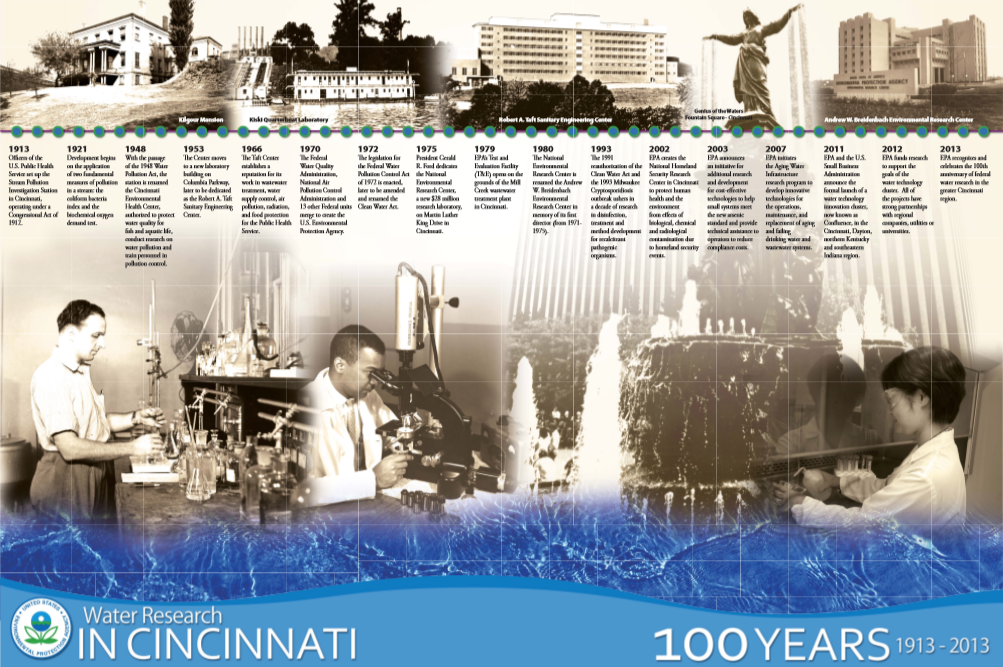The Environmental Protection Agency (EPA) is a federal agency focused on protecting the environment and public health. Cincinnati is one of several EPA locations across the country—the area is home to four facilities for research and development, with its largest location in Uptown.
The Andrew W. Breidenbach Environmental Research Center in Clifton is EPA’s main facility in the area, with engineering, biology, chemistry, and other laboratories dedicated to a range of research areas, including drinking water, hazardous waste management, watersheds, emergency response, and more. EPA’s Office of Research and Development (ORD) conducts leading-edge research to inform EPA’s decisions and supports the emerging needs of stakeholders, including the agency’s state, tribal, and community partners. The Clifton location houses a large contingency of ORD research centers, as well as programs in EPA's Office of Water, Office of Mission Support, and administrative and support functions.
Research completed in Uptown not only impacts the City of Cincinnati, but also different states and communities across the country. EPA’s research helps them assess environmental risks and make decisions about how to solve environmental challenges associated with stormwater, drinking and wastewater, watersheds, and hazardous waste sites. For example, EPA’s local water researchers helped address the water crises in Flint, MI, and Toledo, OH, protecting community members from harmful levels of lead and toxic algal blooms.
“When EPA was established in 1970, Cincinnati already had a long history of federal water and other environmental research here because the region relied so heavily on the Ohio River. So, it made sense for EPA to establish a national research center here,” said Greg Sayles, Director of one of the ORD research centers in Cincinnati. “Over the decades, EPA has worked with local environmental protection organizations including the Greater Cincinnati Water Works, the Metropolitan Sewer District, Ohio River Valley Water Sanitation Commission (ORSANCO), universities, local environmental technology companies, and others, establishing the area as an environmental science powerhouse.”
Research completed in Uptown not only impacts the City of Cincinnati, but also different states and communities across the country. EPA’s research helps them assess environmental risks and make decisions about how to solve environmental challenges associated with stormwater, drinking and wastewater, watersheds, and hazardous waste sites. For example, EPA’s local water researchers helped address the water crises in Flint, MI, and Toledo, OH, protecting community members from harmful levels of lead and toxic algal blooms.
“When EPA was established in 1970, Cincinnati already had a long history of federal water and other environmental research here because the region relied so heavily on the Ohio River. So, it made sense for EPA to establish a national research center here,” said Greg Sayles, Director of one of the ORD research centers in Cincinnati. “Over the decades, EPA has worked with local environmental protection organizations including the Greater Cincinnati Water Works, the Metropolitan Sewer District, Ohio River Valley Water Sanitation Commission (ORSANCO), universities, local environmental technology companies, and others, establishing the area as an environmental science powerhouse.”
Research completed in Uptown not only impacts the City of Cincinnati, but also different states and communities across the country. EPA’s research helps them assess environmental risks and make decisions about how to solve environmental challenges associated with stormwater, drinking and wastewater, watersheds, and hazardous waste sites. For example, EPA’s local water researchers helped address the water crises in Flint, MI, and Toledo, OH, protecting community members from harmful levels of lead and toxic algal blooms.
“When EPA was established in 1970, Cincinnati already had a long history of federal water and other environmental research here because the region relied so heavily on the Ohio River. So, it made sense for EPA to establish a national research center here,” said Greg Sayles, Director of one of the ORD research centers in Cincinnati. “Over the decades, EPA has worked with local environmental protection organizations including the Greater Cincinnati Water Works, the Metropolitan Sewer District, Ohio River Valley Water Sanitation Commission (ORSANCO), universities, local environmental technology companies, and others, establishing the area as an environmental science powerhouse.”
Uptown’s history of research and innovation is clear through EPA, as well as Uptown’s other anchor institutions. Proximity to Uptown’s many research-focused organizations creates ample opportunities for collaboration. EPA has partnered with both the University of Cincinnati and the National Institute for Occupational Health and Safety (NIOSH), which is developing a new consolidated research facility in the Uptown Innovation Corridor.
As new companies and organizations continue to locate in the Corridor, more collaborations are likely to follow. EPA is open to collaborating on research projects, especially if it helps translate laboratory research to real-life applications. Scientists at EPA’s Cincinnati locations currently hold 41 active patents and manage 12 Cooperative Research and Development Agreements (CRADAs) with external partners and 12 commercial licensing agreements under the Federal Technology Transfer Act.
“One thing that’s important at EPA are the scientists and engineers who are focused on and passionate about applied research,” said Sayles. “We’re looking at research that can be immediately used by someone. It’s research that’s not just advancing science; it’s really helping the communities around the country with whatever their environmental problem is.”
EPA’s local impact is clear—its facilities include approximately 980 laboratory jobs with over $88 million annually supporting research efforts.
As EPA celebrates its 50th anniversary in 2020, the organization is looking to build on its history of cutting-edge research.
“For fifty years, EPA employees and our many partners have worked together to fulfill the agency’s mission to protect human health and the environment. Today, Americans enjoy cleaner land, air and water than ever before,” said Andrew Wheeler, EPA Administrator, in a news release. “I look forward to celebrating the agency’s accomplishments throughout the year, and I hope that we can inspire the next generation of environmental leaders to continue building on our progress for the next 50 years.”
For more information about EPA, visit www.epa.gov.



